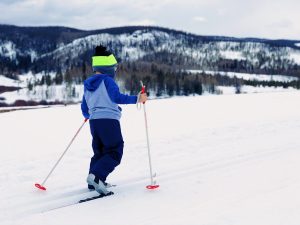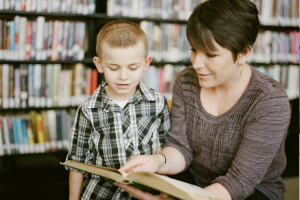Skiing – A Metaphor for Emotional Regulation
 When we enter the world, we transition from an insulated environment to one that is full of challenges. We must learn how to navigate around both expected and unexpected events. It is a journey that is easier for some and more difficult for others. As adults, it can be easy to overlook the process our children go through to develop the skills needed to manage these ups and downs. Between parental limits, schoolwork, and building and maintaining friendships, our children face many opportunities to learn to how to struggle. Learning to ski can be a helpful metaphor to reflect on how our children develop emotional regulation, or their ability to make sense of their emotions as a resource to navigate life’s difficult moments.
When we enter the world, we transition from an insulated environment to one that is full of challenges. We must learn how to navigate around both expected and unexpected events. It is a journey that is easier for some and more difficult for others. As adults, it can be easy to overlook the process our children go through to develop the skills needed to manage these ups and downs. Between parental limits, schoolwork, and building and maintaining friendships, our children face many opportunities to learn to how to struggle. Learning to ski can be a helpful metaphor to reflect on how our children develop emotional regulation, or their ability to make sense of their emotions as a resource to navigate life’s difficult moments.
When learning to ski, some kids will excitedly pull on their gear and embrace the clunky boots and skis on their feet. They are calm, confident and appear to accept the novelty without hesitation or caution. In terms of emotional regulation, these children represent two ways of showing up. They may be the children who impulsively throw themselves into the moment with little concern for the consequences, or they may be the children who respect the challenge but have an easy-going manner as they test and stretch their limits.
Other kids, however, may find the process of gearing up more daunting. Every step is met with hesitation and trepidation: pulling on layers of bulky clothing, jamming one’s feet into stiff and unforgiving boots, and then having each foot strapped onto a long board that slides on the snow. These children respond to unfamiliar situations with fear, resistance, avoidance, or anger. They struggle with novelty, anticipate the worst possible outcome, feel assaulted by the uncomfortable physical sensations, or get demoralized when they can’t successfully coordinate their bodies in this new experience.
Confident or hesitant, the child must eventually face down the mountain. We don’t expect beginner skiers to start with black diamonds, the most extreme terrain, and we don’t expect our children to handle life’s most difficult problems immediately. Just as instructors help new skiers develop their skills on progressively challenging slopes, it is the job of caring adults (parents, teachers, coaches) to help children learn to regulate their emotions through progressively challenging situations.
In order to get down the mountain safely, the bold skier must learn to respect the terrain while the cautious skier must learn to face into the terrain. Either way, the skier must engage with the experience in order to learn how to manage it. In the same way, emotional regulation can only be learned by doing it. Our children must face into adversity and weather the experience to gain the skills needed to navigate successfully in the future. Neither being flippant nor cowardly affords the opportunity to learn how to manage when faced with adversity. As adults, our job is to provide the support and encouragement to help them develop tools to be successful in this process.
While skiers start on the bunny slope, kids may begin to learn emotional regulation when they face a broken toy or the disappointment of being told “no.” The skier learns to find control by working with, rather than fighting against, the mountain, and the child learns to calm himself by accepting, rather than fighting his reality. It is in difficult moments that we lay the foundation for building resilience and tolerance. With time, practice, and guidance from patient and caring adults, children can grow their capacity for emotional regulation.
As parents, or caring adults, it becomes incumbent on us to know when the challenge is manageable for the experience and skill level of the child. Sometimes, we need to step back to allow the child to struggle down the mountain independently. Other times, we may need to set limits or provide more support when the child lacks the appropriate judgment or experience.
Just as we may encourage a new skier to move to an easy less steep green run rather than a steep and bumpy double black diamond after the bunny slope, we may need to help provide direction to a young child taking on a challenge he can’t safely manage. Alternatively, we may need to compel the child to face his fear and take on a more challenging slope. To grow, he must struggle through developmentally appropriate challenges. When adults rescue children from this experience, as in fighting for a teacher to re-grade a paper, the child may develop a false sense of confidence and be ill prepared to manage the next, more difficult situation.
As skiers become more advanced, gearing up and controlling their skis become less cumbersome creating space for new challenges. Now they may be aware of navigating other skiers on the hill, icy patches, and possibly even their own fatigue. The skier’s skill level and experience predicts how competently or gracefully one may manage these new challenges. Importantly though, any skier can loose control. Most of the time one is able to recover quickly, but sometimes the skier may take a day, or even a season, to recover. In the same way, we can expect to face new, more nuanced, challenges as we grew up and engage in more complex situations and relationships.
There will be successes and failures, but the goal is to continue to learn and become more deft. Like skiing, the process of developing emotional regulation is a life-long process that requires continual practice and honing of skills. And when failure happens, because it will, it is important to get back up and reflect on how to better prepare to face that challenge again.
Emotional regulation is fundamental to successfully navigating the unavoidable twists and turns of life. As parents and supportive adults, we can facilitate the development of resilience. There are many questions to keep in mind to support this goal. What is the child’s skill level? What is the terrain/challenge? Is my child bold, fearless, or overconfident, requiring limits to stay safe? Is my child fearful, tentative, or over cautious, requiring support to manage challenges? Is my fear taking hold, knocking down bumps the child needs to learn to navigate?
Considering the process of learning to ski as a metaphor for learning how to regulate or manage emotions can help us keep the bigger picture in mind. Each child comes to the challenge with his/her own unique strengths and weaknesses. The process is therefore particular to each child. Practice with little struggles is necessary to building the capacity to face the larger struggles that will inevitably come in their teenage and adult years. Falling, getting back up, and going at it again are all part of the process. Ultimately, it is about preparing our children to gain the skills to face into challenges and safely navigate the unforeseen terrain that lies ahead on their life’s journey.
Tags: child development, child emotional health, children, children and emotions, emotional resilience, parent child communication, parenting, parenting advice, resilience







